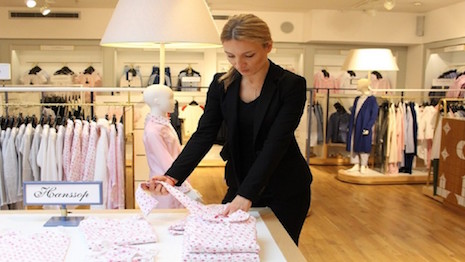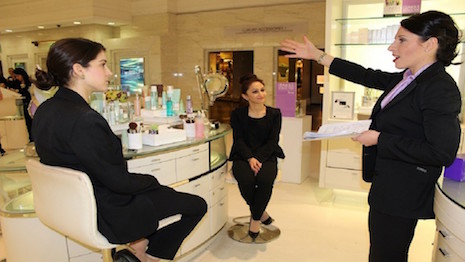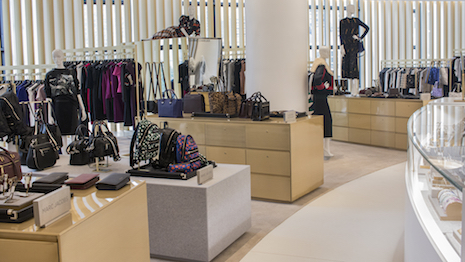
Given its diverse and discerning customer base, London department store Harrods hires sales associates from around the world who align with the brand’s core values
“Pay no attention to that man behind the curtain,” says the Wizard in an iconic scene from the classic movie, “Wizard of Oz.” As Dorothy, Scarecrow, Tin Man and Cowardly Lion stand in awe of the wizard’s image projected on the big screen, complete with pyrotechnic special effects of flashing lights, booming thunder, fire and smoke, Toto pulls back the curtain to reveal the real man pulling the levers.
That reminds me of the current state of luxury marketing today.
New sense
Luxury brands are focused on high-tech smoke-and-mirrors to create even more dazzling and awe-inspiring impressions of their brands that flash up on the screen of consumers’ computers, tablets and mobile phones.
But while so many luxury brands are investing huge amounts of time and money to make those special effects, a few brands such as Intermix, Porsche, Bottega Veneta and Gucci are putting their efforts to where the real power of luxury branding resides: on the people side of the marketing equation.
Milton Pedraza, CEO of the Luxury Institute, and I recently sat down to discuss how our independent research has led us both to a similar conclusion: that person-to-person retail is the most powerful way to bring the luxury value of a brand to the attention of discerning, affluent customers with money to spend.

Milton Pedraza is CEO of the Luxury Institute
So we decided to share as we pull back the curtain of the most underused, yet most powerful marketing strategy available for luxury brands today: the personal relationships made by the customer-facing retail sales staff.
Mr. Pedraza asserts that in their marketing and advertising mix, luxury brands have been focused primarily on the spectacular, new and shiny opportunities offered by technology.
“Retail technology, social media and ecommerce are the hot topics,” he says. “And those are very important.”
But their infatuation with technology is distracting them from focusing on the human element.
Ironically, Mr. Pedraza points to how digitally native, non-luxury brands such as Bonobos and Warby Parker, which have mastered all the high-tech marketing techniques, are now opening stores and bringing their virtual experience into the real world.
“They’re beginning to understand that high-performance customer relationship building is, and will be, the true differentiator, especially as robots and artificial intelligence take over the mundane tasks that retail front-line people are forced to do today,” he says.

Effective retail management is essential to Harrods’ customer focus
Floor customers
Like the Internet disruptors now establishing footholds in traditional retail, established retail brands are waking to the importance of developing their personal relationships with customers.
That too many retailers are underperforming on the shop floor is without question.
“The top 20 percent of sales associates account for 80 percent of the sales,” Mr. Pedraza said. “They are critical to the business. And yet, there is another 80 percent of sales associates who are under-trained, under-utilized and under-performing.
“The high turnover in associates leads to customer turnover and massive amounts of lost potential and revenues,” he said.
The value for brands to realize and develop the potential of their human capital is clear.
“By consistently delivering expertise, empathy, trustworthiness and generosity, sales associates who develop and demonstrate high emotional intelligence deliver extraordinary human experiences, make clients feel special, and create personal emotional connections that drive long-term loyalty,” Mr. Pedraza pointed out.
Indeed, he understands the difficulties for brands to select, train and retain the best sales staff, but knows the competitive advantage when they rise to the challenge.
“’Difficult’ is where you find true and sustainable competitive advantage because no one will follow you there,” Mr. Pedraza says.
The need to develop the person-to-person potential at retail is clear and both the brands as employer and the career sales professionals will benefit.
“Great retail brands in apparel, accessories, automotive and dozens of other retail categories are desperate to find qualified people where you can earn $60,000 to $120,000 in three to seven years as an associate, or manager,” Mr. Pedraza says.
“In specialty retail and luxury, the job of a high performance relationship builder will become far more important, and the individual will be far more skilled,” he says.
“Human relationship-based client conversion and retention will be recognized as the critical drivers of revenues and profits in retail.”

The Saks Downtown store in New York’s Brookfield Place across from the World Trade Center
AS THE ADAGE goes, ‘What is old is new again,’ the heritage luxury brands and the great retailers reached their pinnacle by building extraordinary personal relationships with their customers, day-in, day-out, face-to-face and hand-to-hand. That never should have gone out of style, but unfortunately, too many brands and too many retailers have been seduced by the attractions that technology promises.
Mr. Pedraza and I call on those brands and retailers to get back to what made them great in the first place: the personal relationships built on the sales floor.
This article first appeared in www.luxurydaily.com
Seeking to build and grow your brand using the force of consumer insight, strategic foresight, creative disruption and technology prowess? Talk to us at +9714 3867728 or mail: info@groupisd.com or visit www.groupisd.com

